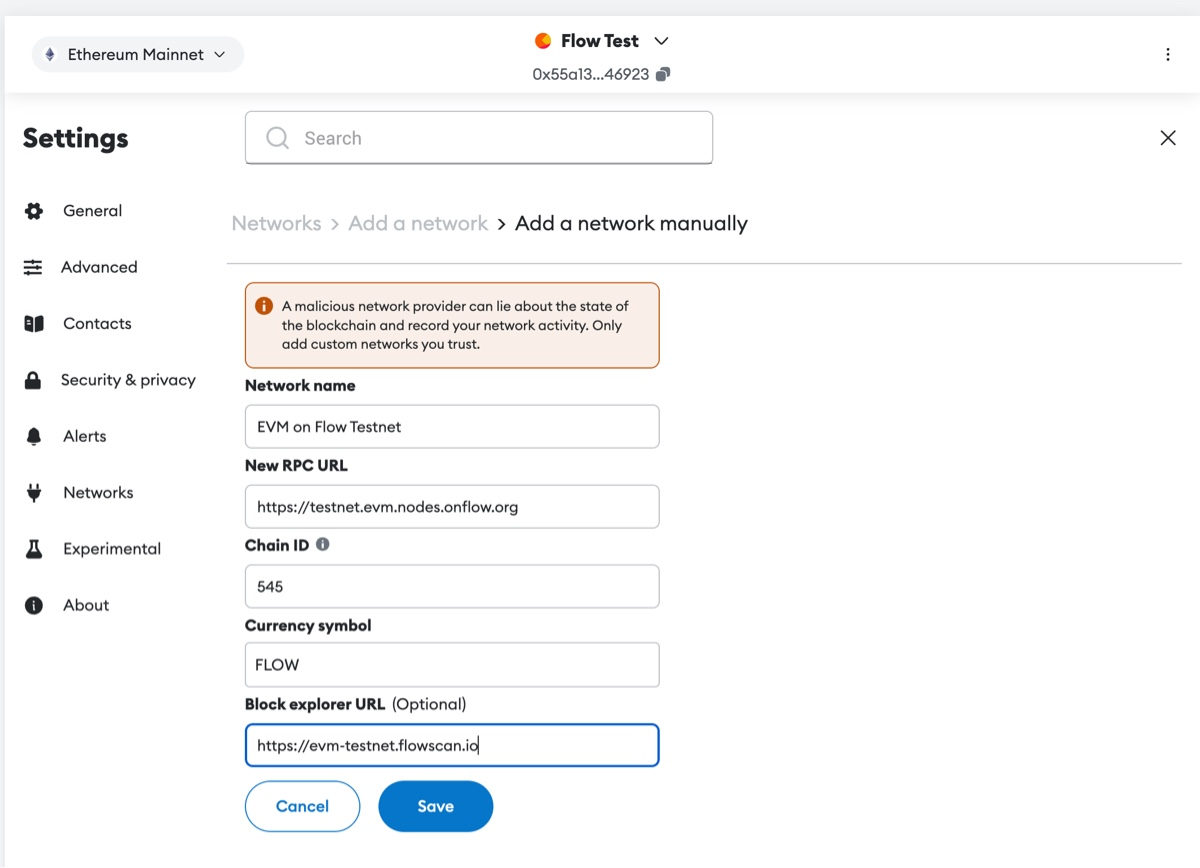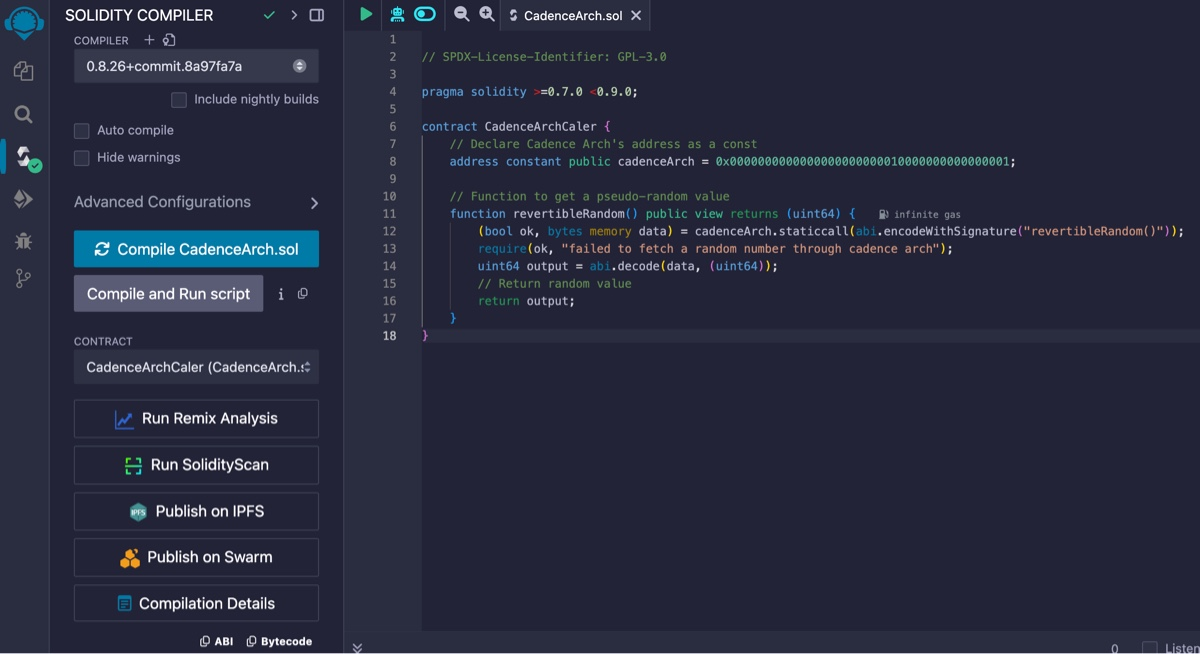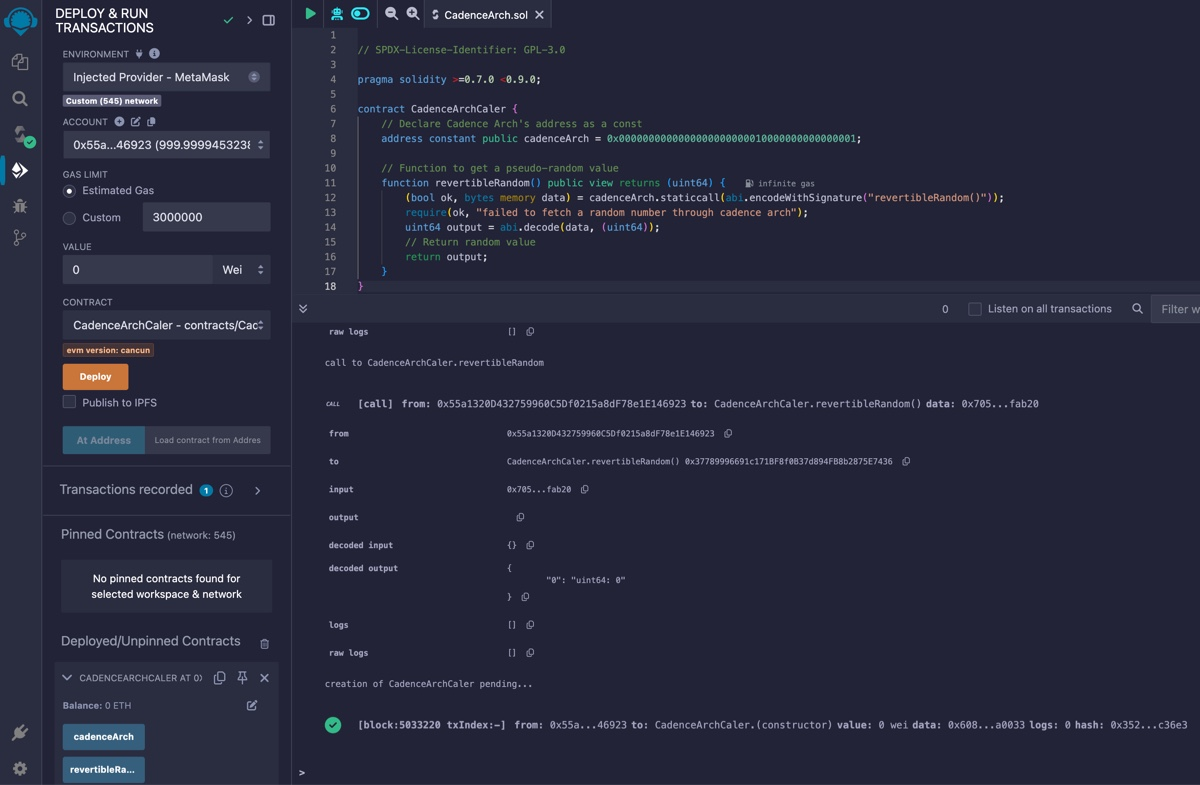VRF (Randomness) in Solidity
Introduction
Flow provides secure, native on-chain randomness that developers can leverage through Cadence Arch, a precompiled contract available on the Flow EVM environment. This guide will walk through how Solidity developers can use Cadence Arch to access Flow’s verifiable randomness using Solidity.
What is Cadence Arch?
Cadence Arch is a precompiled smart contract that allows Solidity developers on Flow EVM to interact with Flow’s randomness and other network features like block height. This contract can be accessed using its specific address, and Solidity developers can make static calls to retrieve random values and other information.
Prerequisites
- Basic Solidity knowledge.
- Installed Metamask extension.
- Remix IDE for compilation and deployment.
- Flow EVM Testnet setup in Metamask.
Network Information for Flow EVM
| Parameter | Value |
|---|---|
| Network Name | EVM on Flow Testnet |
| RPC Endpoint | https://testnet.evm.nodes.onflow.org |
| Chain ID | 545 |
| Currency Symbol | FLOW |
| Block Explorer | https://evm-testnet.flowscan.io |
Steps to Connect Flow EVM Testnet to Metamask
- Open Metamask and click Networks -> Add Network.
- Enter the following details:
- Network Name: EVM on Flow Testnet
- RPC URL:
https://testnet.evm.nodes.onflow.org - Chain ID:
545 - Currency Symbol:
FLOW - Block Explorer:
https://evm-testnet.flowscan.io
- Click Save and switch to the Flow EVM Testnet.

Obtaining FLOW for Testnet
You can fund your account with testnet FLOW using the Flow Faucet. Enter your Flow-EVM testnet address, and you’ll receive testnet FLOW tokens to interact with smart contracts.
Solidity Code Example: Retrieving Random Numbers
Below is a simple Solidity contract that interacts with the Cadence Arch contract to retrieve a pseudo-random number.
_17// SPDX-License-Identifier: GPL-3.0_17pragma solidity >=0.7.0 <0.9.0;_17_17contract CadenceArchCaller {_17 // Address of the Cadence Arch contract_17 address constant public cadenceArch = 0x0000000000000000000000010000000000000001;_17_17 // Function to fetch a pseudo-random value_17 function revertibleRandom() public view returns (uint64) {_17 // Static call to the Cadence Arch contract's revertibleRandom function_17 (bool ok, bytes memory data) = cadenceArch.staticcall(abi.encodeWithSignature("revertibleRandom()"));_17 require(ok, "Failed to fetch a random number through Cadence Arch");_17 uint64 output = abi.decode(data, (uint64));_17 // Return the random value_17 return output;_17 }_17}
Explanation of the Contract
-
Cadence Arch Address:
The
cadenceArchvariable stores the address of the Cadence Arch precompiled contract (0x0000000000000000000000010000000000000001), which is constant across Flow EVM. -
Revertible Random:
The
revertibleRandom()function makes a static call to therevertibleRandom()function to fetch a pseudo-random number. If the call is successful, it decodes the result as auint64random value.
Deploying and Testing the Contract
Compile and Deploy the Contract
- Open Remix IDE.
- Create a new file and paste the Solidity code above.

- Compile the contract by selecting the appropriate Solidity compiler version (0.8.x).

- Connect Remix to your Metamask wallet (with Flow EVM testnet) by selecting Injected Web3 as the environment.

- Deploy the contract.

Call revertibleRandom
After deployment, you can interact with the contract to retrieve a random number.
Call the revertibleRandom() function in the left sidebar on the deployed contract. This will fetch a pseudo-random number generated by Flow’s secure PRG (Pseudorandom Generator).

The result will be a uint64 random number generated on Flow EVM.
Generating Random Numbers in a Range
For use-cases like games and lotteries, it’s useful to generate a random number within a specified range, the following example shows how to get a value between a min and max number.
_17// SPDX-License-Identifier: GPL-3.0_17pragma solidity >=0.7.0 <0.9.0;_17_17contract RandomInRange {_17address constant public cadenceArch = 0x0000000000000000000000010000000000000001;_17_17// Generate a random number between min and max_17function getRandomInRange(uint64 min, uint64 max) public view returns (uint64) {_17 // Static call to the Cadence Arch contract's revertibleRandom function_17 (bool ok, bytes memory data) = cadenceArch.staticcall(abi.encodeWithSignature("revertibleRandom()"));_17 require(ok, "Failed to fetch a random number through Cadence Arch");_17 uint64 randomNumber = abi.decode(data, (uint64));_17_17 // Return the number in the specified range_17 return (randomNumber % (max + 1 - min)) + min;_17 }_17}
Secure Randomness with Commit-Reveal Scheme in Solidity
The revertibleRandom() function can be directly used to generate a pseudo-random number. However, in certain situations, especially involving untrusted users, this function exposes a vulnerability: the ability of a transaction to revert after seeing the random result.
The Issue with Using revertibleRandom() Directly:
- When an untrusted party calls a contract function that uses
revertibleRandom(), they receive the random number during the transaction execution. - Post-selection is the ability of the caller to abort the transaction if the random outcome is unfavorable. In this case, the user could choose to revert the transaction (for example, if they lose a bet) and attempt to call the function again in hopes of a better outcome.
- This can lead to a form of transaction reversion attack, where the randomness can be exploited to repeatedly attempt transactions until a favorable result is obtained.
Example Attack Scenario:
Consider a decentralized coin toss using revertibleRandom():
- A malicious user could interact with the smart contract and immediately check whether they won.
- If they lost the bet, they could programmatically revert the transaction before it is finalized.
- This allows the user to retry and reattempt the random process multiple times until they win, undermining the fairness of the system.
Time-Locked Randomness with Commit-Reveal
The commit-reveal scheme solves the post-selection problem by splitting the random process into two phases:
- Commit Phase: The user commits to a hidden guess (via a hash of their guess and a nonce) before the randomness is revealed. This locks the user into their guess without revealing it to the smart contract or anyone else.
- Reveal Phase: After the randomness is securely generated and made public (e.g., using
revertibleRandom()or another source), the user can then reveal their guess and nonce to complete the process.
Why This Is More Secure
- No Post-Selection: In the commit phase, the user cannot manipulate the random number because they are committed to their bet or action without knowing the outcome. Once they’ve committed, they are locked into their choice.
- Time Delay Between Commitment and Reveal: By forcing the randomness to be generated after the commitment is made, users cannot use any immediate information about the random number to influence their decision.
- Immutable Commitment: The use of a cryptographic hash (such as SHA-256) ensures that the user cannot change their guess after seeing the randomness. They must reveal the exact nonce and guess used during the commitment phase to verify the validity of their reveal.
Commit-Reveal Scheme Example for a Random Coin Toss
Here is a Solidity implementation of a coin toss game using a secure commit-reveal scheme, where participants bet on the outcome (heads or tails), and randomness is fetched from the Cadence Arch contract.
_63// SPDX-License-Identifier: GPL-3.0_63pragma solidity >=0.7.0 <0.9.0;_63_63contract SecureCoinToss {_63 address constant public cadenceArch = 0x0000000000000000000000010000000000000001;_63_63 struct Bet {_63 uint256 amount;_63 bytes32 commitment;_63 bool revealed;_63 uint64 result;_63 }_63_63 mapping(address => Bet) public bets;_63_63 // Step 1: Commit the bet by submitting a hash (commit phase)_63 function commitBet(bytes32 commitment) public payable {_63 require(msg.value > 0, "Bet amount must be greater than zero");_63 require(bets[msg.sender].amount == 0, "Already committed a bet");_63_63 bets[msg.sender] = Bet({_63 amount: msg.value,_63 commitment: commitment,_63 revealed: false,_63 result: 0_63 });_63 }_63_63 // Step 2: Reveal the bet by providing the preimage (reveal phase)_63 function revealBet(uint64 nonce, uint64 guess) public {_63 Bet storage bet = bets[msg.sender];_63 require(bet.amount > 0, "No bet to reveal");_63 require(!bet.revealed, "Bet already revealed");_63_63 // Check that the commitment matches the hash_63 require(keccak256(abi.encodePacked(nonce, guess)) == bet.commitment, "Invalid commitment");_63_63 // Fetch a secure random number from Cadence Arch_63 (bool ok, bytes memory data) = cadenceArch.staticcall(abi.encodeWithSignature("revertibleRandom()"));_63 require(ok, "Failed to fetch a random number");_63 uint64 randomNumber = abi.decode(data, (uint64));_63_63 // Determine the result (0 = loss, 1 = win)_63 bet.result = randomNumber % 2;_63 bet.revealed = true;_63_63 // Pay the winner double the bet amount if they won_63 if (bet.result == guess) {_63 payable(msg.sender).transfer(bet.amount * 2);_63 }_63 }_63_63 // To reset and clean up after the reveal_63 function resetBet() public {_63 require(bets[msg.sender].revealed, "Bet not yet revealed");_63 delete bets[msg.sender];_63 }_63_63 // Helper function to generate the commitment hash (off-chain or in Remix)_63 function getHash(uint64 nonce, uint64 guess) public pure returns (bytes32) {_63 return keccak256(abi.encodePacked(nonce, guess));_63 }_63}
Steps to Interact With the Coin Toss Contract
Step 1: Commit Phase
You need to generate a commitment hash from a nonce (random number) and your guess (0 for heads, 1 for tails).
-
Call the
getHashfunction to generate the commitment hash:_10getHash(12345, 1); // nonce: 12345, guess: 1 (tails)Example Output:
0x5f5766a7a5d18bb9a9c3040a7b672c5c8f4860018ebd5a11f1678f11f2326c44. -
Call
commitBet(bytes32 commitment):- Input the generated commitment hash into the commitBet function.
- Enter the amount of FLOW to bet in the Value input box in Remix.
- Example: Enter
1to bet 1 FLOW.
Step 2: Reveal Phase
-
Call
revealBet(uint64 nonce, uint64 guess)to reveal your bet:_10revealBet(12345, 1); // nonce: 12345, guess: 1 (tails) -
The contract will fetch a secure random number from Cadence Arch and determine whether you won or lost based on the outcome (0 for heads, 1 for tails).
Read More
For further details on Flow’s randomness and secure development practices, check out the Flow Randomness Documentation. You can also view an exammple in both Solidity and Cadence of a cointoss implentation using the VRF.
This documentation was contributed by Noah Naizir, a community developer.